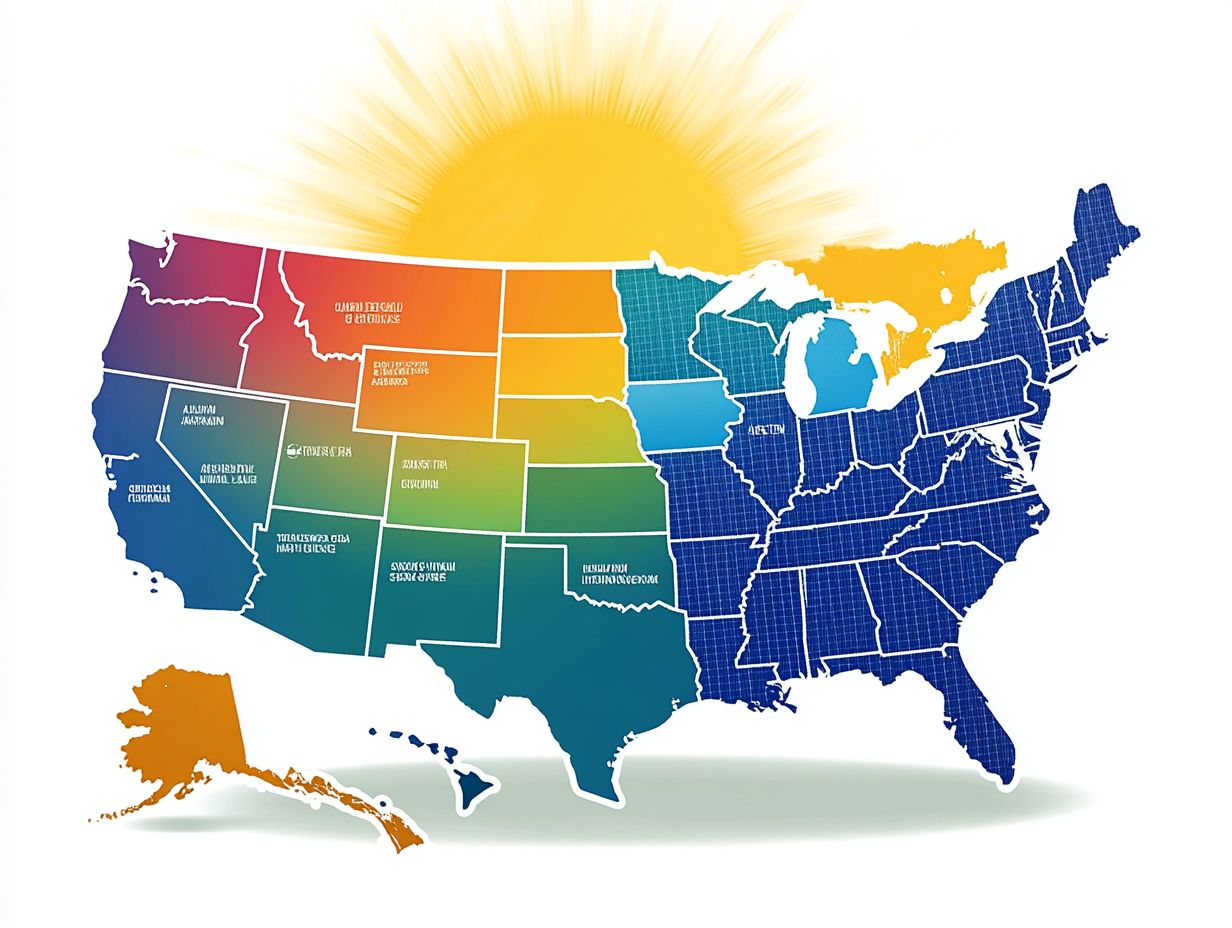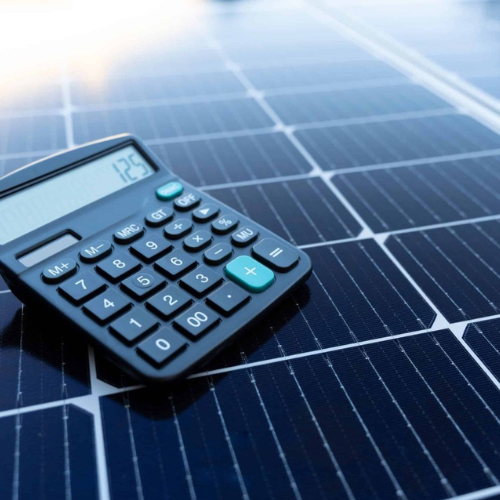Contents
- 1 How the Estimator Works
- 2 Key Benefits of Using a Solar Savings Estimator
- 3 Maximizing Savings with a State-Specific Solar Savings Estimator
- 4 Interpreting and Applying the Results from Your Solar Estimator
- 5 Frequently Asked Questions (FAQs) About Solar Estimators
- 5.1 What is a State-Specific Solar Savings Estimator?
- 5.2 Why is a State-Specific Solar Savings Estimator important?
- 5.3 How does a State-Specific Solar Savings Estimator work?
- 5.4 Are State-Specific Solar Savings Estimators Free to Use?
- 5.5 How accurate are the results from a State-Specific Solar Savings Estimator?
- 5.6 Can I use a State-Specific Solar Savings Estimator for any state?
Curious about how much you could save by switching to solar energy? A solar savings estimator might be exactly what you need.
Our handy tool takes various factors into account to give you a personalized estimate of your potential energy savings. This article dives into how these solar estimators work, discusses their accuracy, and highlights the benefits of using them.
You’ll also find guidance on a state-specific solar estimator, along with tips for getting the best results. So, jump in and discover how you can make informed decisions about your solar investment!
What is a Solar Savings Estimator?

A Solar Savings Estimator is a fantastic tool that helps you figure out the financial perks of investing in solar energy, whether you’re a homeowner considering residential solar or a business owner exploring commercial solar options.
It takes into account various factors like installation costs, state-specific solar incentives, and utility rates, giving you a clear picture of your potential solar savings.
Plus, it highlights tax credits and solar incentives available in your state, which can really boost your energy efficiency and help reduce your carbon footprint.
With this powerful resource, you can navigate the often confusing world of renewable energy investments with ease.
By considering things like your average energy consumption and local sunlight exposure, it shows you how much energy your photovoltaic solar panels could generate over time and how that could impact your electricity costs.
The Solar Savings Estimator also shines a light on the long-term solar ROI, giving you the power to make informed choices about solar financing options and potential monthly savings.
This tool not only simplifies your decision-making process but also encourages you to adopt more sustainable energy solutions.
Barbose, G., Darghouth, N., Millstein, D., Spears, M., Wiser, R., Buckley, M., Widiss, R., & Grue, N. (2016). Tracking the Sun: Installed Price Trends for Distributed Photovoltaic Systems in the United States. Lawrence Berkeley National Laboratory. Link
How the Estimator Works
The Solar Savings Estimator works by looking at some specific data you provide, like your energy consumption, local regulations, and current utility rates.
It then calculates how much you could save by utilizing the strength of solar energy and achieving energy independence.
It takes into account various factors, including the type of solar panels you’re considering, installation costs, and the financing options available to you.
In the end, it gives you a clear picture of what you can expect in terms of energy production and cost savings over time.
Factors Considered in Calculations
When you use the Solar Savings Estimator, it takes several key factors into account to give you accurate predictions of your solar savings and projected savings.
Think about your energy consumption patterns, the efficiency of the solar panels you choose, local utility rates, available solar incentives, and the overall energy production potential in your area.
Understanding your energy consumption is crucial. If your household uses a lot of energy, you can expect to see bigger savings when you make the switch to solar.
For example, if you rely heavily on electricity for heating and cooling, you might notice a significant drop in your bills.
The efficiency of your solar panels also matters for maximizing kWh savings and solar output. Higher efficiency panels can squeeze out more energy from less space, which can really boost your overall savings.
And let’s not forget about local utility rates—if electricity costs are high in your area, going solar usually makes a lot more financial sense.
Plus, there are solar incentives like tax credits, rebates, and solar subsidies that can cut your initial costs dramatically, making solar systems much more accessible.
Your geographical location plays a role too; areas that get plenty of sunshine will likely see better results.
Just look at the case studies from California, where homeowners have reported exceptional returns on their investment and significant household savings!
Accuracy and Limitations
While the Solar Savings Estimator is designed to give you accurate projections, it’s important to keep in mind its limitations.
Factors like your energy consumption, state regulations, and the latest advancements in solar technology can all affect the results.
Think of the results as a guideline rather than a guarantee since they rely on ever-changing variables like energy market trends and possible shifts in utility rates.
Given this complexity, consulting with solar professionals and local installers can really boost the accuracy of those estimations.
These experts can take a look at your specific situation, such as roof orientation, shading issues, and local incentives that the estimator might not fully consider.
Also, remember that outside factors like weather patterns, fluctuations in energy prices, and new innovations in solar panels can impact your final cost savings.
Consider ways to mitigate these factors by exploring flexible financing options and staying updated on policy changes.
You can tackle these uncertainties by staying informed and seeking expert insights, making sure your decisions are well-informed and tailored to your unique circumstances.
Key Benefits of Using a Solar Savings Estimator
Using a Solar Savings Estimator can really work in your favor, particularly when considering energy efficiency and sustainability. It gives you a clearer idea of how much you could save by switching to solar energy.
By figuring out the expected cuts in your energy bills, thanks to energy efficiency and any available solar rebates, you can make smart choices about investing in solar systems for your home or business.
This way, you’ll not only improve your financial strategy but also make a positive impact on the environment with eco-friendly solutions.
Understanding Potential Savings

Understanding potential savings is key when you’re thinking about investing in solar energy and achieving energy independence.
The Solar Savings Estimator can really help you break down what you can expect to save on your utility bills, taking into account things like your current electricity rates and the solar financing options available to you.
By looking into the solar incentives out there, you can optimize your return on investment and make smart choices about how you consume energy.
For example, you might want to check how the size of your property, the angle of your roof, and its direction toward the sun can impact your overall energy generation.
If you have a larger home in a sunny area, you might find that you can save more compared to a smaller place that doesn’t get much sunlight.
Don’t forget to consider how federal and state tax credits, along with local rebates, can really slice those upfront installation costs.
These credits can significantly enhance your overall savings and return on investment.
Plus, with low-interest financing options becoming easier to find, the savings from solar energy can often outpace your monthly payment obligations, putting you in a position of net-positive cash flow in many situations.
Comparison to Other Methods
When you compare the Solar Savings Estimator to other ways of evaluating solar energy potential, it really shines with its user-friendly interface and thorough data analysis capabilities.
It takes into account important factors like your energy consumption, solar capacity, and the latest advancements in solar technology.
Unlike those old-school methods that make you do extensive manual calculations, this estimator streamlines everything and gives you real-time insights into solar performance, energy production, and savings.
This innovative tool not only boosts the accuracy of your calculations but also includes the latest trends in energy efficiency and solar market dynamics.
You can expect detailed breakdowns of potential savings over time, considering fluctuations in energy costs and system performance metrics specific to where you live.
The Solar Savings Estimator even has a handy comparison feature, letting you easily visualize your savings next to conventional energy sources and understand the benefits of grid-tied systems versus off-grid systems.
This is a game-changer compared to traditional approaches that often rely on outdated assumptions or generalized data.
Its impressive ability to adapt to your personal usage patterns, including demand response and energy policy considerations, makes this estimator the go-to choice for anyone looking for reliable solar solutions.
Maximizing Savings with a State-Specific Solar Savings Estimator
Using a state-specific Solar Savings Estimator is key to maximizing your potential solar savings and understanding the energy landscape.
It takes into account local solar market trends, state policies, and the incentive programs available in your area, including solar community programs and household savings opportunities.
With this localized approach, you’ll get the most relevant and accurate calculations, making it easier for you to understand your potential return on investment with solar energy.
Step-by-Step Guide to Using the Solar Savings Estimator
Using the Solar Savings Estimator is a straightforward way to help you figure out your solar savings, get accurate predictions based on your unique situation, and engage with solar assessments.
Start by doing an energy audit to evaluate how much energy you’re currently consuming and perform an energy consumption analysis.
Then, check out the installation costs and look into available solar assessments, including solar resource assessment, so you can input the right data into the estimator.
Once you’ve gathered your energy usage data, it’s a good idea to research local solar incentives, financial models, and rebates that might apply to your area. These can significantly enhance your overall savings potential.
Next, take a good look at your roof space and orientation since these are key factors in figuring out how efficient your solar panels will be and achieving optimal solar capacity.
With all this information ready, you’re set to enter your data into the estimator.
Don’t forget to double-check all your inputs for accuracy! The quality of those projections really depends on the information you provide, including inputs for solar mapping and resource optimization.
When you review the output, take the time to compare various scenarios and consider state comparison. This will help you make informed decisions about potential investments in solar technology.
Tips for Accurate Results
To get the most accurate results with the Solar Savings Estimator, you should consider a few tips that can really boost the quality of your data input and ensure accurate financial projections.
For example, conducting a shading analysis and using solar resource mapping can make a big difference in determining your solar output and performance metrics.
By entering your energy consumption data precisely and taking local shading conditions into account, you’ll be able to get a much more reliable estimate of your potential solar savings.
It’s also super important to double-check your numbers to avoid common slip-ups like typos or miscalculations that can easily throw off your results.
When you’re entering your monthly energy usage figures, rounding incorrectly can lead to some pretty significant differences in the final energy savings and projected savings estimate.
Don’t forget to assess your roof’s orientation and tilt angle, too, since these factors play a big role in how much solar energy you can capture with your residential solar or commercial solar setup.
Plus, regularly updating your estimates with current electricity rates, incentives, and tax credits will keep your calculations relevant, ensuring you get the most accurate and beneficial insights into your solar panel installation and overall solar investment.
Interpreting and Applying the Results from Your Solar Estimator

Interpreting and using the results from the Solar Savings Estimator is a key step in your journey toward adopting renewable energy.
It helps you shape your energy management strategies and informs your decisions about solar energy investments, including photovoltaic system choices and net metering benefits.
By grasping the projected savings, solar incentives, and overall feasibility of solar projects, you can confidently steer your energy transition and achieve significant energy independence.
Skoplaki, E., & Palyvos, J. A. (2009). On the temperature dependence of photovoltaic module electrical performance: A review of efficiency/power correlations. Solar Energy, 83(5), 614-624. Link
Understanding the Data
Understanding the data from the Solar Savings Estimator is key to grasping your potential solar savings. You’ll get insights into your energy consumption patterns, cost savings, and how much energy you can expect from those installed solar panels, contributing to your overall energy efficiency and reduction in utility bills.
By analyzing this data, you can identify trends and make smart decisions about your energy management strategies, investments in solar technology, and potential financing options like solar loans or solar leases.
When you analyze and interpret the data, focus on those crucial metrics, like energy offset percentages, return on investment (ROI), and the payback period for your solar system.
These metrics illustrate the financial impact, operational efficiency, and potential kWh savings of your solar solution, giving you a clearer idea of the overall value.
Adding visual aids like charts can really boost your understanding; for example, a graph that compares monthly energy production to consumption can reveal peak usage times when you can maximize your savings through optimized energy consumption habits and efficient solar power utilization.
By taking a closer look at this visual data, you’ll gain a better appreciation of how your solar savings change over time, which will help you adjust your energy consumption habits strategically and meet your long-term energy goals.
Making Informed Decisions
Making informed decisions based on the results from the Solar Savings Estimator can really pay off. You could enjoy benefits like increased energy independence, lower energy bills, and even a boost in your property value over time, thanks to the environmental benefits and sustainability of your solar adoption.
By weighing these advantages against installation costs, maintenance costs, and financing options like power purchase agreements (PPAs), you’ll be in a much better position to find a solar energy solution that suits your needs.
As you explore this exciting path, don’t forget to consider potential government incentives, solar subsidies, and tax credits that could help offset those initial expenses. This can make the switch to renewable energy even more attractive and financially viable.
Taking a look at long-term benefits, like stable energy costs, reduced carbon footprint, and your contribution to environmental sustainability, can really enhance the value of your investment.
It’s also important to analyze your energy consumption patterns and see how solar integration can easily fit into your lifestyle, contributing to your overall energy solutions and sustainability goals.
With a well-informed approach, you’ll be empowered to tackle the complexities of adopting solar energy confidently, ensuring you make the best choice for your financial situation and future.
Consider consulting with local installers and using state-specific solar resource assessments for more precise guidance.
Frequently Asked Questions (FAQs) About Solar Estimators
What is a State-Specific Solar Savings Estimator?
A State-Specific Solar Savings Estimator is a user-friendly tool that calculates the potential cost savings, solar ROI (return on investment), and return on investment for installing solar panels in a specific state.
It takes into account factors such as local weather patterns, electricity rates, and solar incentives to provide a more accurate estimate of potential savings.
Why is a State-Specific Solar Savings Estimator important?

Using a generic solar savings estimator may not provide accurate results for a specific state. A State-Specific Solar Savings Estimator takes into account state-specific factors, state regulations, and policies, providing a more precise estimate of savings, solar returns, and ROI.
How does a State-Specific Solar Savings Estimator work?
A State-Specific Solar Savings Estimator uses data such as your location, current energy usage, and local utility rates to calculate the potential savings and ROI of installing solar panels in your state.
It also considers any state-specific incentives or policies, solar mapping data, and financial models that may affect the cost and return on investment.
Are State-Specific Solar Savings Estimators Free to Use?
Most State-Specific Solar Savings Estimators are free to use and can be found on various solar company websites or state government websites.
However, some may require you to enter personal information or contact details to receive a personalized estimate. Using these tools can help you get accurate solar quotes and compare different solar financing options.
How accurate are the results from a State-Specific Solar Savings Estimator?
The accuracy of the results from a State-Specific Solar Savings Estimator will depend on the quality and reliability of the data used.
It is important to use an estimator from a reputable source and to understand that the results are an estimate and not a guarantee of actual savings.
Conducting energy audits and reviewing solar assessments can also enhance the accuracy of your projections.
Can I use a State-Specific Solar Savings Estimator for any state?
No, most State-Specific Solar Savings Estimators are designed for a specific state or region.
It is important to use an estimator that is specific to your state as factors such as weather patterns, energy rates, and solar capacity can vary significantly between states.
Utilizing state comparison tools can also help in understanding these differences.
For the most accurate results, consider verifying your estimates with a solar professional.







